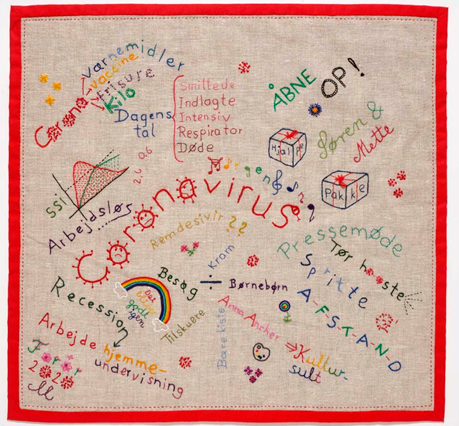Disrupted Temporalities
The term permacrisis describes the entanglement of multiple crises such as climate change, the Ukraine war, the COVID-19-pandemic etc. We investigate how these co-present crises disrupt the temporalities of everyday life; routines, rituals, and vernacular notions of pasts, presents, and futures.

Textile embroidered during the first covid related lockdown in March 2020. Some of the Danish buzz words that became omnipresent were embroidered on the blanket. Source: Roberto Fortuna, National Museum of Denmark
With the Covid-19 pandemic, its aftermath, and other co-present crises as a laboratory, this ethnological project investigates everyday temporalities across Denmark, Finland, Norway, and Sweden.
These countries share similarities: entwined histories, geographies, and welfare states, but the Ukraine war highlighted salient differences (e.g., experiences of war). The different handling of the pandemic and prepping for war foster internal comparison in the Nordics.
Archives and museums are documenting the experiences of these crises in everyday life, which provides solid comparative ground for investigating the vernacular understandings of disrupted everyday temporalities of the pandemic and the affectively entangled and co-present crises articulated in archival and ethnographic materials.
The project’s aim is to advance an understanding of how multiple temporalities are practised within everyday lives, and how such practices activate repositories of pasts and care for futures within routinization and domestication of crises.
Our ethnological investigation begins with these research questions:
- How were disrupted temporalities articulated and materialised within everyday practices during the pandemic?
- How are futures anticipated, repositories of past crises activated, and how do the disrupted everyday temporalities unfold in the pandemic aftermath? And which co-present crises become entangled and how?
- Which similarities and differences regarding how multiple temporalities, pasts, presents, and futures, are disrupted and practised can be identified across Denmark, Finland, Norway, and Sweden?
We explore these questions by way of replies to folklife archives and follow-up ethnography.
Denmark
- Nationalmuseets Etnologiske Undersøgelser (NEU), National Museum of Denmark
- The Folklore Archives, Special Collections, the Royal Danish Library
- Arbejdermuseet
- Dansk Sygeplejehistorisk Museum
- Den Gamle By
- Glud Museum
- Museum Mors
- Museum Vestfyn
- Museum Vestsjælland
- Kolding Stadsarkiv
- Københavns Stadsarkiv
- Ringkøbing Fjord Museerne
- ROMU
- Vendsyssel Museum
Sweden
- Nordiska Museet’s digital memory collections
- Folklivsarkivet i Lund, University of Lund
Finland
- The Cultural Sciences Archive Cultura at Åbo Akademi University
- Society of Swedish Literature in Finland
- Finnish Literature Society
Norway
- Norsk Etnologisk Granskning, Norwegian Folk Museum
- Norwegian Museum of Science and Technology
- Professor Kyrre Kverndokk (Cultural Studies, University of Bergen)
- Professor Monique Scheer (Historical and cultural anthropology, University of Tübingen)
- Senior curator, PhD Audun Kjus (Norwegian Folk Museum)
- Professor emeritus, Orvar Löfgren (Ethnology, Lund University)
Researchers
Internal
| Name | Title | Phone | |
|---|---|---|---|
| Damsholt, Tine | Professor | +4551298920 | |
| Poulsen, Rasmus Rask | Postdoc |
External
Professor Lars-Eric Jönsson, Ethnology, Lund University
Professor Frederik Nilsson, Ethnology, Åbo Akademi University
Postdoc Elin von Unge, Stockholm City Museum
Postdoc Karin Sandell, Ethnology, Åbo Akademi University
Postdoc Marie Eberson Degnæs, Norwegian Folk Museum
Funding
 Project period: 1 March 2024 – 28 February 2026
Project period: 1 March 2024 – 28 February 2026
PI: Lars-Eric Jönsson
Co-PI: Tine Damsholt
Co-PI: Frederik Nilsson
